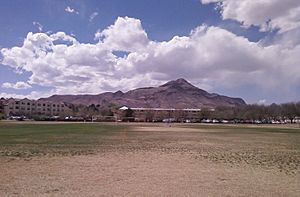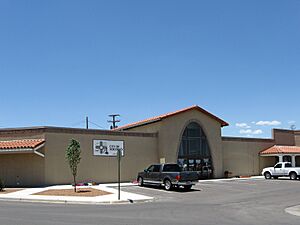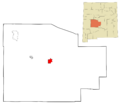Socorro, New Mexico facts for kids
Quick facts for kids
Socorro, New Mexico
|
|
|---|---|
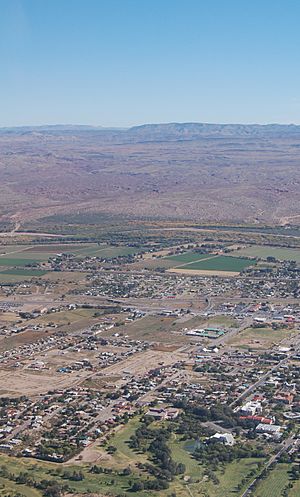
Socorro aerial view
|
|
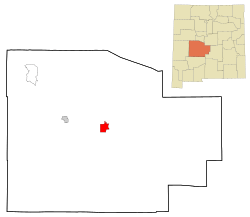
Location of Socorro in Socorro County, New Mexico
|
|
| Country | United States |
| State | New Mexico |
| County | Socorro |
| Area | |
| • Total | 14.46 sq mi (37.46 km2) |
| • Land | 14.45 sq mi (37.43 km2) |
| • Water | 0.01 sq mi (0.03 km2) |
| Elevation | 4,675 ft (1,425 m) |
| Population
(2020)
|
|
| • Total | 8,707 |
| • Density | 602.39/sq mi (232.59/km2) |
| Time zone | UTC−07:00 (Mountain (MST)) |
| • Summer (DST) | UTC−06:00 (MDT) |
| ZIP Code |
87801
|
| Area code(s) | 575 |
| FIPS code | 35-73540 |
| GNIS feature ID | 2411919 |
Socorro (pronounced sə-KOR-oh) is a city in Socorro County, located in the state of New Mexico in the United States. It sits in the Rio Grande Valley at an elevation of about 4,579 feet (1,396 meters). In 2020, about 8,707 people lived there. Socorro is the main city and government center of Socorro County, also known as the county seat. It is located about 74 miles (119 km) south of Albuquerque.
Socorro is also home to important scientific equipment. For example, the LINEAR program, which looks for objects in space, has its instruments nearby. These are at the Lincoln Laboratory's Experimental Test Site, which is part of the White Sands Missile Range.
Contents
History of Socorro
How Socorro Was Founded
In June 1598, a Spanish explorer named Juan de Oñate led a group of settlers. They traveled through a very tough desert area called the Jornada del Muerto. When they came out of the desert, they were tired and hungry.
Luckily, Piro Native Americans from the village of Teypana helped them. They gave the Spanish settlers food and water. Because of this help, the Spanish renamed the village "Socorro," which means "help" or "aid" in Spanish. Later, this name was also used for another nearby Piro village called Pilabó.
Around 1626, the first Catholic mission in the area was likely built. It was called Nuestra Señora de Perpetuo Socorro. Records from that time suggest about 600 people lived in the area. Mines in the Socorro mountains also started operating by 1626.
Challenges and Rebuilding
In 1680, during the Pueblo Revolt, Spanish people had to leave New Mexico. Many stopped in Socorro before going further south to safety. Some Piro Native Americans went with them. After the Spanish soldiers left, Socorro and its Piro people were open to attacks from other tribes like the Apache. By 1692, the village was in ruins.
The Spanish did not immediately return to Socorro after they took back New Mexico. For many years, there were no Spanish settlements south of Sabinal (which is about 30 miles or 48 km north of Socorro). This changed in the 1800s.
In 1800, Governor Fernando Chacón ordered Socorro and other villages to be resettled. However, people didn't start living in Socorro again until about 1815. By 1817, 70 families from Belen asked for land in Socorro. A count in 1833 showed over 400 people living in Socorro itself, and 1,774 people in the surrounding area.
The San Miguel de Socorro mission was built soon after Socorro was resettled. It was constructed on the old ruins of the Nuestra Señora de Socorro mission.
Socorro in the United States
In August 1846, during the Mexican–American War, the American Army took control of New Mexico. American troops stopped in Socorro on their way to Mexico. An officer from Britain, Lt. George Ruxton, described the soldiers as "unwashed and unshaven, were ragged and dirty, without uniforms..."
In September 1850, New Mexico became a territory of the United States. At that time, New Mexico included what is now the states of New Mexico and Arizona. In 1850, Socorro had only 543 people, including 100 American soldiers who soon moved away.
The first military base near Socorro was Fort Conrad, about 30 miles (48 km) south. It was built in August 1851 but was not well made. It was soon replaced by Fort Craig, which opened on March 31, 1854.
The railroad arrived in Socorro in July 1880. This helped the town grow a lot. Socorro became a center for mining lead and zinc.
The New Mexico School of Mines, now known as the New Mexico Institute of Mining and Technology, was started in Socorro in 1889.
On April 24, 1964, a local police officer named Lonnie Zamora said he saw a flying saucer and two small beings. This event is known as the Lonnie Zamora incident.
Geography and Climate
Socorro is about 75 miles (121 km) south of Albuquerque. Its average height above sea level is about 4,605 feet (1,404 meters). The city is next to the Rio Grande river. The land around Socorro has many old volcanoes and is part of the Rio Grande rift.
The area has a big difference in height, from the Rio Grande to the Magdalena Mountains, which is about 6,000 feet (1,829 meters). Important places nearby include the Cibola National Forest, the Quebradas Back Country Byway, and the Bosque del Apache and Sevilleta National Wildlife Refuges. The city covers about 14.4 square miles (37.3 sq km), with only a small part being water.
Weather in Socorro
Socorro has a cold semi-arid climate. This means it's usually dry. Summers are hot, with temperatures reaching 90°F (32°C) on about 82 days each year. Winters are mild, but nights can be cold, with temperatures dropping to or below freezing about 126 days a year.
The hottest temperature ever recorded was 109°F (43°C) on June 26, 1994. The coldest was -16°F (-27°C) on December 21, 1909. Socorro gets about 10.05 inches (255 mm) of rain each year. Most of the rain falls in July.
People of Socorro
In 2000, there were 8,877 people living in Socorro. About 3,415 households were counted. The population density was about 615.8 people per square mile (237.8 per sq km).
The people of Socorro come from many backgrounds. In 2000, about 66% were White, and over 54% were Hispanic or Latino. About 25% of the people were under 18 years old. The average age was 31 years.
Most people in Socorro speak English at home (about 62%). Spanish is also widely spoken (about 35%).
Economy and Tourism
Major employers in Socorro include the New Mexico Institute of Mining and Technology (NM Tech), the Bureau of Land Management, Socorro General Hospital, and the National Radio Astronomy Observatory. Local governments and schools also provide many jobs.
Fun Things to Do
Elfego Baca Golf Shoot
The Elfego Baca Golf Shoot is a unique event named after a former mayor of Socorro. This golf game starts by hitting the ball from Socorro Peak, also called M Mountain. This peak is 7,243 feet (2,208 meters) high. Golfers then try to get their ball down the mountain to a single hole almost three miles (5 km) away!
Places to Visit
- San Miguel de Socorro – A historic mission church.
- National Radio Astronomy Observatory Very Large Array – A huge collection of radio telescopes.
- Bosque del Apache National Wildlife Refuge – A place to see many kinds of birds and wildlife.
- Sevilleta National Wildlife Refuge – Another large wildlife refuge.
- Trinity (nuclear test) site – The location of the first atomic bomb test.
- Owl Bar and Cafe – A famous local restaurant.
Education in Socorro
The Socorro Consolidated School District serves about 2,000 students. It has one public high school, Socorro High School.
Socorro is also home to the New Mexico Institute of Mining and Technology, often called New Mexico Tech. This is a state university that focuses on research and teaching. It has about 1,500 undergraduate students and 500 graduate students. New Mexico Tech also hosts the Summer Science Program in Astrophysics, where students can learn about stars and space.
Transportation
Roads
- Interstate 25: This highway goes north through Albuquerque and south to Las Cruces.
- U.S. Route 60: This road goes east through Clovis and west through Magdalena into Arizona.
- NM 1
- NM 439
Trains
Freight trains use a BNSF line that runs from Belen, New Mexico to El Paso, Texas. Passenger train service stopped in 1968.
Airport
Socorro has an airport on the southern edge of the city. In the early 1950s, Continental Airlines offered flights there using a Douglas DC-3 plane. A small airline called Zia Airlines also made stops there in the mid-1970s. Today, the airport is used for general aviation, meaning smaller private planes.
Famous People From Socorro
- Elfego Baca (1865–1945): A lawman, lawyer, and politician.
- Jeff Bhasker: A record producer and musician.
- Holm O. Bursum (1867–1953): A politician.
- Conrad Hilton (1887–1979): The person who started the Hilton Hotels chain.
- Robert Fortune Sanchez (1938–2012): A Roman Catholic archbishop.
- Jan Thomas (1958-): A children's writer and illustrator.
Images for kids
See also
 In Spanish: Socorro (Nuevo México) para niños
In Spanish: Socorro (Nuevo México) para niños



